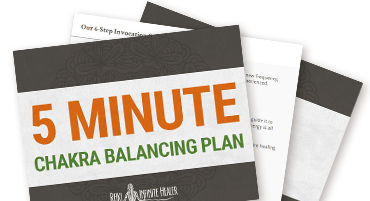The BEST Yoga Poses to Pair with Reiki

Yoga, as we know it today, is quite different from where it started.
With television shows, advertisements, and even your local gym focusing solely on its physical practice, it's easy to forget that the purpose of the practice is to channel our life force energy towards a deeper, spiritual understanding!
I love pairing yoga with my Reiki practice. By practicing them both, the effects from my Reiki-based healing are amplified.
To understand how yoga works hand in hand with Reiki, let's talk first about the spirituality of yoga.
The Spirituality of Yoga
Yoga follows an 8-limb path, which serves as an ethical guide for a complete Yoga practice.
These 8 limbs are:
1. Yamas- Moral restraints. There are 5 Yamas, which are:
- Non-harming
- Truthfulness
- Non-stealing
- Continence
- Non-Covetousness or Letting Go
2. Niyamas - Moral observances. There are also 5 Niyamas, which are:
- Cleanliness
- Contentment
- Fire
- Study of the Self
- Surrender to Force
3. Asanas - Physical practice of postures.
4. Pranayama - Breath and Breath control.
5. Pratyahara - Sense withdrawal.
6. Dharana - Steadfastness of concentration.
7. Dhyana - Meditation.
8. Samadhi - Enlightenment.
The westernization of Yoga has focused mainly on limb 3—Asana. However, Asana is just a small part!
By encompassing the entire spiritual and physical purpose of yoga, we can use it to complement Reiki healing.
But how do we go back to connecting with the original intent and spirit of the practice as it was designed almost 3,000 years ago?
The answer is Chakras...
The Exploration of Chakras
In combination with the 8 limbs, yoga follows subtle energy centers that are located along the spine and skull, from root to crown. If you're familiar with Reiki, you know these energy centers are called "Chakras".
While chakras are not physically visible or tangible, their existence is powerful and necessary for your connection to the universe. Essentially, chakras can be viewed as houses for your spiritual beings, and help connect you to the outside world that we call Planet Earth.
As life carries on, and you acquire knowledge along the way, your chakras take in the information you receive through your experiential lens and send it through your physical and emotional body.
While there is no perfect recipe to make sure your chakras are running at optimal function and capacity 100% of the time, a healthy yoga practice can amplify the role Reiki plays in keeping chakras developed and healthy.
Pairing Yoga with Reiki
All experiences, positive and negative, live within the petals of the chakras. Both physical and emotional injuries trickle down and affect chakra growth and development.
If the injury is not addressed, the affected chakra will become blocked!
This causes energy to be hindered and unable to move freely.
As a chakra become blocked, the chakra will become underdeveloped.
Blocked chakras cause greater problems the longer they remain.
The block will move up the spine into each subsequent chakra, until healing and release are introduced. With prolonged blockages, you can experience a spectrum of symptoms with coinciding effects when these areas are damaged, ranging from physical illness to emotional debilitation.
I spent many years and many tears in a state of blocked chakras. The energies I felt (and didn't feel) left me with a sense of loss, groundlessness, and self-doubt.
Luckily, I've spent the better part of 10 years diving into understanding and re-connecting to my true Self and spirit that live on a non-visible but very real entity within my soul.
If you would like to read more about the practice of yoga and chakra development, I recommend Anodea Judith's Eastern Body, Western Mind.
This is why yoga is a great complement to Reiki!
Next we'll take a look at the best yoga poses I use for Chakra development...
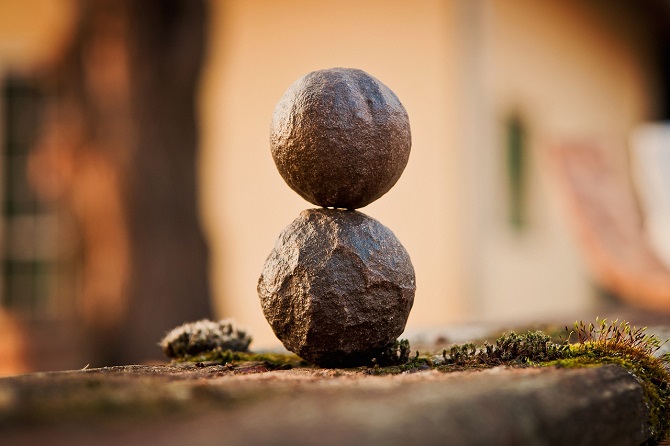
The BEST Yoga Practices for Chakra Cleansing
I recommend you focus on your most troubled chakras and use the best poses for that chakra in addition to your daily Reiki practice.
Muladara

Muladara, or root chakra, is developed in the beginning stages of life while in the womb.
This chakra develops your "Right to Be", is located at the base of your spine, and is represented by the color red as you move from your Spiritual state to your Human state. This is your first stage of existence, and the energy of Muladara develops simultaneously as the development of the exoskeleton.
The qualities of Muladara are earthy and grounding.
Beginnings. Foundational. Stabilization. Survival. Nourishment. Familial.
Positive and balanced energy in Muladara results in prosperity and trust, while negative and unbalanced energy manifests as fear and uncertainty.
Developing and strengthening the Muladara chakra is fundamental to reconnecting with the earth. When you are put in fearful situations or experiences, your inner spirit is trying to escape and go to a place of safety, causing an ungrounded or flighty mental state. Your tendency to not be present is tremendously increased and the result creates a blockage to the intuitive mind and body.
To re-ground, try this sequence of meditation and asana:
Come to a comfortable, supported seat, known as Sukhasana, or a sweetly seated position.
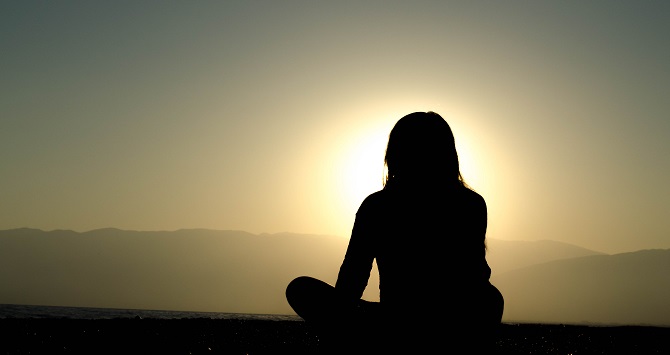
Your sit bones should connect to a blanket or a cushion, but raised higher than your knees so that you can have space for the energy to move freely. Bring your hands to your knees, palms open, in a receiving gesture.
Keep the eyes open, but the gaze soft, also known as Drishti. Keeping the eyes open helps you connect with your surroundings and reduces fear that can often be a result associated with closing the lids. As you keep a steady gaze, actively engage with your breath. Count the breaths, and create longer exhales than inhales. An example count is:
Inhale: 1-2-3-4
Exhale: 5-4-3-2-1
Continue this breath for 10 rounds. After you have established a breath pattern, start to reach the arms up.
As the finger tips reach to the sky, inhale. As you exhale, release the arms down and feel the magnetic pull of gravity under your seat. You may even feel a slight shift or movement, and that's okay!
Follow this for another 10 rounds of breath. You may also introduce a mantra that centers around freedom from fear. This mantra focuses on the Yama Ahimsa, or non-harming, as well as the Niyama Saucha, or cleanliness. The mantra can go as follows:
Inhale: "I am safe and I am free."
Exhale: "Abundance lives within me."
These two together create a relationship between being kind to yourself through assurance of safety and clearing the thoughts in the mind towards positivity.
As you move on, come to a standing position, known as Tadasana, or Mountain pose.
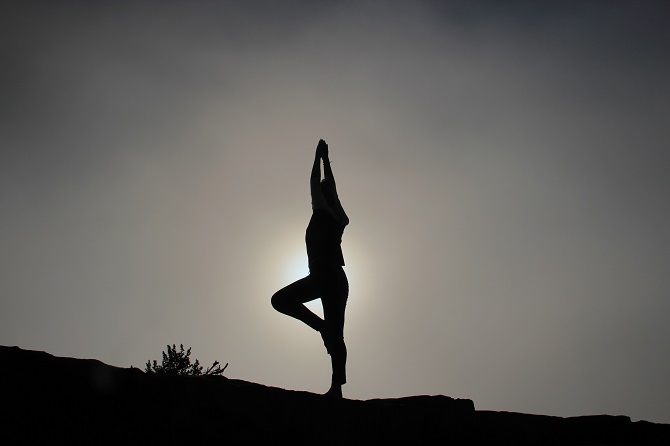
If you lose your connection to the earth as you shift into this position, that's alright. Just re-establish your breath as quickly as you can when you get to your stand. As you reconnect to the breath, stand with your arms by your side, palms facing forward. Re-introduce your mantra:
Inhale: "I am safe and I am free."
Exhale: "Abundance lives within me."
With the shift of your body, see if you can feel the gravity pulling you down beneath your feet. Imagine you can feel the energy coming up from that gravitational pull, as it sends up to the crown of your head on your inhale.
As you exhale, follow this imaginary flow back down into the feet, and into the earth. Let this create a circle of grounding energy, going from root to tip and back down to root again.
As you have continued this flow of energy, give a little weighty quality to your breath. Can you hear your breath? Can it create a whisper in the back of your throat? This is your Ujjayi breath.
As you engage the Ujjayi pranayama (breath), start to lift the arms up over head on the inhale. The exhale creates a bend in the knees as you fold forward. Once you are there, you are in Uttanasana, or forward fold.
Remember, you're practicing non-harming as well. Keep the knees bent, and separate feet to widen your stance for more stability.
Grab opposite elbows and feel the Ujjayi-fueled breath continue the flow of energy. Now that you're in this forward fold, the energy from the earth goes only to the hips, and goes back down the spine to the crown of the head, and reconnects the crown of the head to the earth, which are now much closer.
This renewed cycle of energy is continuously fed from the earth and creates the foundation to reconnect with your right to be here, safely and securely.
Svathistana

Svathistana, or the sacral chakra, is developed around the age of 2. This is the "Right to Feel" chakra, is represented by the color orange, and is located in the space pubis and sacrum. This is also known as your "sex" chakra, and is the place where your sexuality is derived and developed.
The sacral chakra has a liquid quality to it and utilizes the water element.
It is flowing and moving. Sensational. Emotional. The house of change.
Positive and healthy balance energy in Svathistana manifests in pleasure, while negative and unbalanced energy results in guilt and neediness.
Asana practice around rebalancing the Svathistana inherently thrives off of flowing movement and hip release. Because the sacral joint connects to the hips, it is the first place of constriction.
To unblock this chakra, try this sequence of meditation and asana:
First, come to Hasta Balasana, or extended child's pose. As you bring your hips to your heels, find space for your chest to comfortably rest by spreading your knees wide.
Reach the arms out in front of you. This position will also connect you to muladara chakra. As you find that grounded energy of muladara, this pose may bring in a sense of uneasiness. Breathe in to the space and develop your mantra around the Yama Satya (truthfulness) and Niyama Santosa (contentment).
Inhale: "I have the right to feel."
Exhale: "I have the right to be joyous."
Stay in Child's pose for at least 5 breaths. As you prepare to move, root your hands and start to lift your chest away from the floor. Tuck the toes and root down to lift your hips up, into Downward Facing Dog. Keep the knees bent, and find a gentle, liquid quality to the body.
Follow the subtle movements of your energy and play with a little flow going from Downward Facing Dog to Child’s pose. Allow this movement to be free, and engaged by the breath.
After 8 rounds of this freedom of flow between Child's pose and Downward Facing Dog, find a steady hold in downward dog.
As you continue to integrate grounding, feel a gentle lift of your right leg on an inhale. As you exhale, bring the right foot forward in between the hands, and release the left knee to the ground.
Inhale and lift the arms up. You’re now in Anjaneasana, or Crescent Lunge.
Use a full breath to reach the arms up, and as you exhale, bring the arms back down, plant the hands, and step back to Downward Facing Dog. Repeat on the left side.
As you flow through, do one round on each leg, and return back to Child's Pose. Begin the whole process again, and witness the feeling you are getting through the front of the hips as you're unlocking the space to go a little deeper.
The breath is still Ujjayi. As you continue this mini-sequence, you're UNLOCKING YOUR POTENTIAL and creating connection of movement to feeling. As you feel, see what moves. As you move, see what you feel.
As you build, you can start to add on Virabhadrasana B, or Warrior 2.
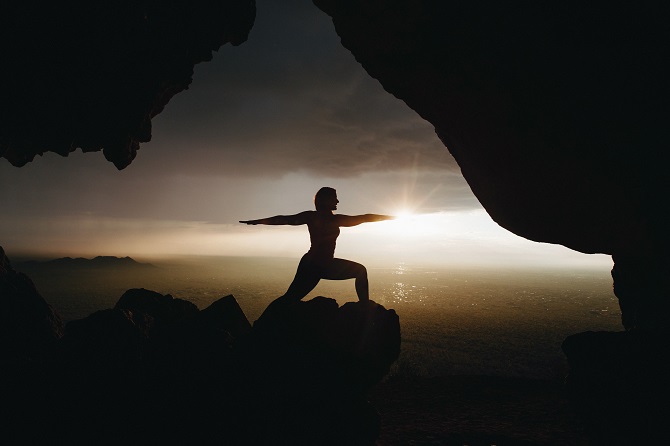
As you come into crescent lunge on the right side, tuck your back toes and lift the knee. Once you're established in what is now a high lunge, spiral your back foot down and bring your right arm forward, your left arm back.
Warrior 2 is a great pose to radiate your energy from the center of the body, out to the limbs! Pay careful attention of how the flow of energy moves from the front position to the side.
Warrior 2 is an asymmetrical pose with external rotation, which allows the energy from the sacral area to release as it opens. Keep this flow going from right to left, and listening to the body for moments of pause and rest in Child's pose.
Explore with freedom of movement and energy. Watch carefully and feel what your energy is providing for you. If you want to hold further, respect that. If your body is telling you to slow down, listen to that too. Engage and feel, as that is what the Svathistana is meant to do.
(By the way, I also created a collection of 18 audio sessions that guide you step-by-step through balancing and healing your auras and chakras with Reiki...if you're feeling as though something is a bit off in your life, health, or relationships, check out this guided healing program now.)
Manipura
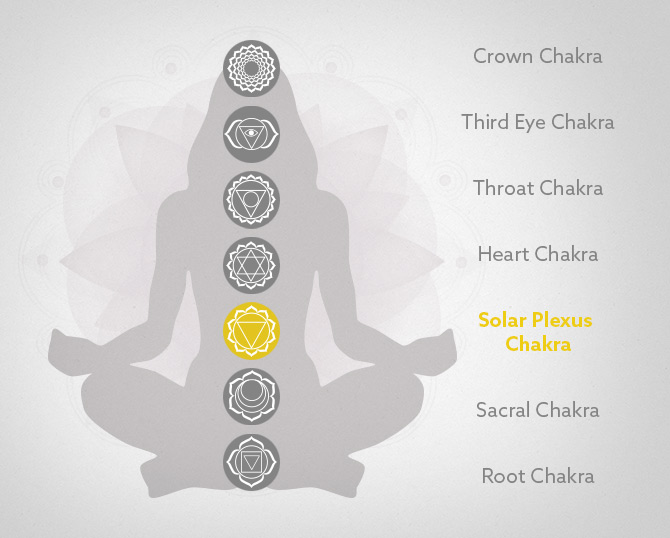
Manipura, or the solar plexus, is the chakra of fire.
It is developed by the age of 4 and is represented by the color yellow.
This one is where personality starts to show its bright and shining self. Manipura sits just behind the belly, and governs digestion, activity, willfulness, discipline, self-esteem, and individuality. A weakened Manipura chakra can result in low energy, stomach problems, and listlessness.
If the first two chakras remain underdeveloped, energy to animate the body cannot move freely.
Manipura thrives off of opening and feeling, but must also be grounded. A Manipura practice can become chaotic and erratic if the first two chakras are not opened to receive the fueling energy for the fire within.
However, the fuel from the Manipura is where we can start to get into the fun stuff. This is place for release of energy, integration of activity, and sparking creativity!
To engage the Manipura chakra, start with a pranayama practice called Kabalabhati, or Dragon's breath.
You can start in a seat, but if you come to a wide-legged stand, with the knees bent and the feet turned out, you can move directly into the asana practice that follows this breath.
For the Manipura chakra, try this sequence of meditation and asana:
Bring your hands to your wide, bent legs. Take several cleansing breaths in and out. Let the breath be full on the inhale, vigorous on the exhale.
After about 5 rounds of this breath, take your next inhale in, but only half of your capacity. Find a forceful exhale out of the nostrils, as the belly draws in to add to the force.
Take a slight inhale in to provide material for your next exhale, once again pulling from the belly and forcefully out the nostrils. This breath is willful action and starts to fuel the fire in the belly, also known as the Niyama, Tapas.
Follow this short inhale and forceful exhale out about 30 times. When your 30 breaths are complete, bring it all back down with 5 deep inhales and exhales. Repeat this process 3-5 times, and feel the fire of energy start to radiate from your center all the way out.
Since you're in this wide-legged stance already, find your inner Goddess (men, you have an inner Goddess too!) Take a nice, deep inhale as you lift your arms up and the legs straighten. As you exhale disintegrate and crumble with control. Open your mouth wide and let out a sigh through your exhale as you come down! Let your inner being roar out!
As you move through this, can you sit back and watch your movement with your inner spirit at a bird's eye view? Can you let this movement come solely from energy and not from muscular movement?
It's okay if you can't differentiate the two right away. But just imagine what it would be to create a separation from the energetic body from the muscular body. This is where your Svathistana comes into play with Manipura and you allow yourself to get deeper with feeling.
Keep this flow through your Goddess pose for about 10 times. When your energy has hit its peak, start to shift to the Virabhadrasana A, or Warrior 1. Shorten your stance, turn the feet back in.
Bring your left leg back and plant the foot down, keep the right leg bent. Engage Muladara as you root your feet down and lift your arms up. Can you re-engage that circle and cycle of energy that you found in your Muladara stance?
As the energy continues to come alive, YOU HAVE CONTROL. You are willfully guiding this energy and movement. You have power and cognition, and you can let it work for you. As you establish your grounding in your warrior, bring your left leg from the back to wrap around the right leg.
This is Garudasana, or Eagle's Pose. Bring your arms to a T-shape and follow up by wrapping the left arm under the right. Maybe you hug yourself, or maybe you bring your palms together.
Can you imagine your energy has a shape? Through this Eagle pose, you’re recapturing your energy and changing its shape. As you hold this energy in its new shape, feel its power in you. From this Eagle pose, shift to Virabhadrasana C, or Warrior 3.
Allow this expansion to come from ease and control. Bear witness to the transition. You are decidedly in awareness of this shift. As this flow continues, you can add in a vinyasa transition from one side to the other.
The development of awareness starts to manifest into control of energy. This is where you are starting to move from your outside feeling body to the inner workings of your soul. It doesn’t matter how pretty or seemingly perfect this pose is, it's what you feel along the journey.
Brahmacharya. Self-control. You're aware and in control of this flow.
Anahata
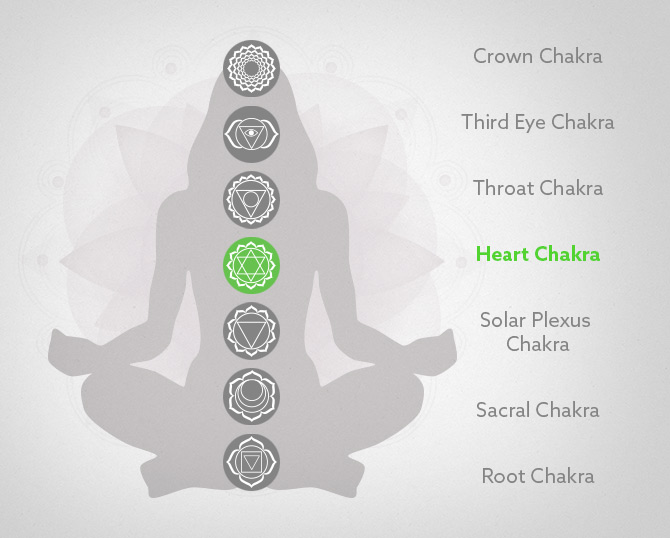
Anahata, or the heart space, is the place of giving and receiving, and lives behind the heart muscle.
Represented by the color green and developed between the ages of 4 and 7, Anahata has an airy quality and is easily swayed and influenced by external factors. This is the home of relationships, love, compassion, devotion.
A pained Anahata chakra suffers from feelings of rejection or lack of acceptance. In other words, it's a broken heart.
Personally, I have struggled for most of my life with rejection and my heart was in a seemingly permanent broken state. It wasn't until I was able to free my heart from its entrapment that I started to feel love and acceptance.
But just like the rest of the practices, the heart cannot and will not open...if there is nothing there to open it with.
Encouragement through grounding, feeling, and moving energy is the way let the heart be free to beat, free to love, free to be.
Because the heart beat is an involuntary muscle response, it's perfectly okay and even encouraged to open up slowly and sweetly through a Yin or Restorative approach.
To cleanse the anhata, try this sequence of meditation and asana:
Find a connection of the first 3 chakras as you focus your attention on the fourth. Get two blocks...one for in between your shoulders, one for the base of your skull. Arms come to a T. Turn the palms up, and allow the eyelids to soften down.
As you allow yourself to relent onto these blocks, feel the grounding energy or the magnetic gravity pull your backside down to the floor and heavier into the blocks. Your legs can be long, but you can engage Svathistana again by bringing your feet together into a bound angle pose.
As you continue to fall heavy into the floor and onto the blocks, can you spark up the color green to your mind?
Can you focus on this green color, and watch how it changes shape and brightness as your body rises and falls with the breath?
Can the breath travel down into the belly, to create a liquid flow like melted wax from the Manipura up to the Anahata?
Allow this practice to be the place where you start to shift from a willfully driven practice to a willingness to observe and watch what unfolds.
Keep the breath steady. You're in a place of Ishvara Pranidhana, or in the process of surrender. You're giving energy back into yourself, not stealing from yourself. It's time to integrate a mantra again:
Inhale: "I am that."
Exhale:"And that is enough."
Affirmation of self-acceptance creates and manifests an INCREDIBLE POWER and ABUNDANCE of healing energy.

As you surrender in the ground, into your own space, and you start to clear out what's blocking your heart, can you feel the walls tearing down inside of you?
It's slow...it’s gradual.
It won't happen overnight.
Can you devote enough of your spirit and what is deep within to be steadfast and willing?
Watch the liquidity of energy float like air though your sheath of being. Patience and love, acceptance and understanding. The quiet stillness of this pose reflects those qualities. Allow it to go deep and do its healing as you nourish your body with breath and your soul with devotion.
Visshuda

Visshuda, or the throat chakra, is the house of your voice, literally and figuratively.
It is represented by the color blue. This chakra develops between the ages of 7 and 12, and starts the transition from the age of innocence to the status of communication and establishment of personality and ego.
This is also the chakra where we start to move away from the physical body and start moving into our more subtle spiritual energy as we get into the higher chakras.
A healthy Visshuda shows up in CREATIVITY and SELF-EXPRESSION, while a damaged Visshuda experiences inferiority and troubles relating to the outside world.
One of the strongest healing practices for the energy of Visshuda is very direct and re-connects us to the outside world that can plague us.
Om.
Om, in its truest essence and form, is the connecting vibration between you, the universe, and the space around you. It's almost like the calling card for your spirit to get in touch with home.
If you are having trouble with your Vissuda, try a "Rolling Om" pratice in your yoga routine:
A "Rolling Om" practice stimulates the vibrations deep within and stimulates the throat. To begin, come into Sukhasana. Make sure you're as comfortable as you can be, and lift your heart to the sky as you sit tall.
Before you start the rolling om practice, you can repeat a devotional prayer, inspired by Thich Nhat Hanh
I inhale, and I am aware that I inhale.
I exhale, and I am aware that I exhale.
I inhale inside, I exhale outside.
I inhale to the sky, I exhale to the earth.
I inhale and I’m in the present moment, I exhale, and this moment is beautiful.
A Rolling Om practice is achieved by connecting to the earth, and pulling the Om from the depths of your muladara.
It travels up from root, to sacral, to belly, to the heart, and exits out the mouth.
The vibrations create a sense of calm and relaxation.
To start, breathe in deeply. As you breathe in, the feel the awakening inside. Slightly part the lips, and as you exhale, let the Om ring, in whichever tone works best for you. If you are in a room with others, find the voice that calibrates with the general sound and energy of the room.
As you move in and out of the Om, there’s no need to wait for a prompt to move on to the next one. Go with your feeling, with your mind, and where your heart is leading you. See if you can complete 9 rounds.
The more time you spend connecting with the deeper energy stimulated by Om, the better healing you will receive from your own nourishment of your soul. Breathe, take it in, and feel it all.
When you take it in, you'll begin to feel more balance in your life...
I go way more details on breath work and creating balance in my Guided Healing Sessions Premium Collection, which I want to share with you now. Click the image below to check it out!
Anja

Anja, better known as the "third eye", is the energy that bridges the gap between the feeling body chakras and the higher self.
Anja is represented by indigo, is developed during adolescence, and manifests into intuition, dreams, transcendence, and imagery. Disillusion of Anja creates confusion and set-up for manipulation.
The practice of understanding and playing with Anja's healing energy comes from combining Aparigraha, or non-covetousness, Svadyaya, the study of the sacred Self, Dharana, or concentration.
These are all evaluated through Dhayana, or the practice of Meditation.
This is one practice that will help you integrate the feeling body chakras in with the concentration towards intuition is a meditation of awareness of Self:
Come to your seat again.
As you turn down the eyes, focus on the breath. As the breath comes in, repeat to yourself:
Inhale: "Rising."
Exhale: "Falling."
This is just the beginning.
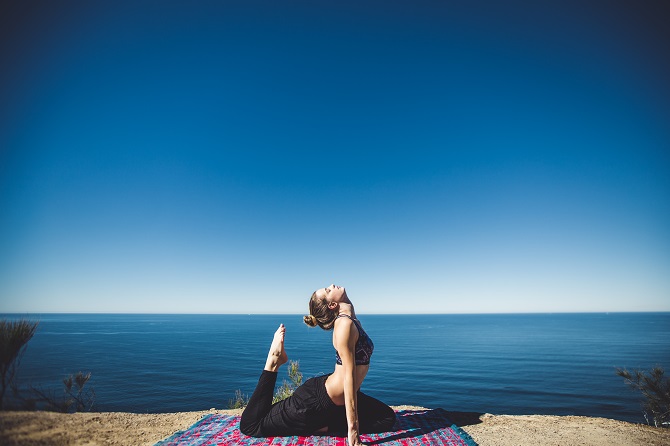
Each day, this practice will build. After you've established "Rising, Falling", it's time to add on direction.
Inhale: "Rising."
Exhale: "Falling."
Pause: "Right side."
Inhale: "Rising."
Exhale: "Falling."
Pause: "Left side."
And again, the next day, add on a little more:
Inhale: "Rising."
Exhale: "Falling."
Pause: "Right side."
Pause: "Right hip."
Inhale: "Rising."
Exhale: "Falling."
Pause: "Left side."
Pause: "Left hip."
And more:
Inhale: "Rising."
Exhale: "Falling."
Pause: "Right side."
Pause: "Right hip."
Pause: "Right spine."
Inhale: "Rising."
Exhale: "Falling."
Pause: "Left side."
Pause: "Left hip."
Pause: "Left spine."
Keep these practices going for 15-20 minutes each time.
As you move into the spine, you're engaging with the masculine and feminine energies known as Ida and Pingala. Ida resides on the left side and governs femininity, emotion, creativity. Pingala is the masculinity we all have, and controls practicality, understanding, and "groundedness".
The awareness of these starts to balance the circular energies that live within all of us, but also gives rise to a deeper connection within ourselves.
Sahasrara

Sahasrara or Enlightenment, is the ULTIMATE state of being.
This is the place of Samadi, or complete bliss and satiation, and is where spirit meets the physical body and creates a co-habitation as one, not separate.
It's purple in color and it is the quintessential point of awareness, consciousness, and higher being. It develops in early adulthood and carries on throughout a human's Earth life.
The arrival at Enlightenment is a debatable topic. While many of us are constantly on the path towards true enlightenment, we may not know what that really means. I have my enlightened moments, but I find more a place of understanding through empowerment.
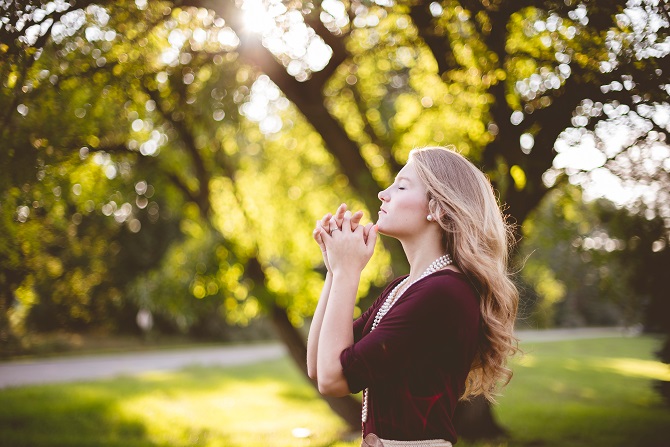
Sahasrara is the achievement you get after the practices of the first six chakras have created balance and awareness. Once we integrate these practices into the fibers of our being, both physically and spiritually, we can create a clear pathway towards this enlightened state. Enlightenment is a unifier of all beings on Earth and beyond, and the awareness of consciousness is revealed.
The path to Enlightenment is not always straight-forward. Sometimes you might feel like you're on the cusp, and you fall down and have to start all over again. Sometimes you only climb a little bit, and you fall down again.
But with practice, devotion and understanding, you can enjoy and see all that energy in the chakras has to provide. Even if you only reach the Enlightened state for half a second you were able to bear witness to the process and the evolution of your own spiritual being.
But as you practice, you learn to SEE and to KNOW. You see that what is within you is beyond you, and does not define you yet is beautiful and resilient.
It sees no depth, no obstacle.
Even though it's bounded in this life form, ITS POWER IS BOUNDLESS.
Connection creates understanding to this being.



